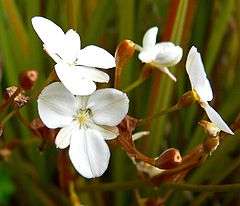Libertia
| Libertia | |
|---|---|
| | |
| Libertia grandiflora | |
| Scientific classification | |
| Kingdom: | Plantae |
| (unranked): | Angiosperms |
| (unranked): | Monocots |
| Order: | Asparagales |
| Family: | Iridaceae |
| Subfamily: | Iridoideae |
| Tribe: | Sisyrinchieae |
| Genus: | Libertia Spreng. 1824, conserved name not Dumort. 1822 (syn of Hosta) nor Lej. 1825 (syn of Bromus) |
| Type species | |
| Libertia ixioides (Forster f.) Spreng. | |
| Synonyms[1] | |
| |

Libertia is a genus of monocotyledenous plants in the family Iridaceae, first described as a genus in 1824.[2] It is native to South America, Australia, New Guinea, and New Zealand. Several of species are endemic to New Zealand.[1][3][4]
They are all perennials growing from short woody rhizomes, with simple, linear or narrowly lanceolate basal leaves which are often green but may be red or yellow depending on the species. The showy white trimerous flowers are open in spring and are followed by capsules opening by three valves which contain the numerous black seeds.
The genus was named after the Belgian botanist Marie-Anne Libert[5] (1782–1865) (also referred to as Anne-Marie Libert).[6]
- Species[1]
- Libertia chilensis (Molina) Gunckel - central + southern Chile, southern Argentina, Juan Fernández Islands
- Libertia colombiana R.C.Foster - Colombia, Ecuador, Peru, Bolivia
- Libertia cranwelliae Blanchon, B.G.Murray & Braggins - North Island of New Zealand [3]
- Libertia edgariae Blanchon, B.G.Murray & Braggins - North Island of New Zealand[3]
- Libertia falcata Ravenna - Los Lagos region of Chile
- Libertia flaccidifolia Blanchon & J.S.Weaver - North Island of New Zealand
- Libertia grandiflora (R.Br.) Sweet - North + South Islands of New Zealand
- Libertia insignis Ravenna - Los Lagos region of Chile
- Libertia ixioides (G.Forst.) Spreng. - North + South Islands of New Zealand
- Libertia mooreae Blanchon, B.G.Murray & Braggins - North + South Islands of New Zealand[3]
- Libertia paniculata (R.Br.) Spreng. - eastern Australia [7] - Branching Grass Flag
- Libertia peregrinans Cockayne & Allan - North + South + Chatham Islands of New Zealand
- Libertia pulchella (R.Br.) Spreng. - New South Wales, Victoria, Tasmania, North + South Islands of New Zealand, New Guinea[4][8]
- Libertia sessiliflora (Poepp.) Skottsb. - central Chile
- Libertia tricocca Phil. - central + southern Chile
- Libertia umbellata Ravenna - Los Lagos region of Chile
- formerly included[1]
Numerous names have been coined using the name Libertia, referring to species that are now regarded as better suited to other genera (Bromus Cardiocrinum Hosta Orthrosanthus). We provide links to help you find appropriate information.
- Libertia arduennensis - Bromus bromoideus
- Libertia arundinacea - Bromus bromoideus
- Libertia azurea - Orthrosanthus multiflorus
- Libertia cernua - Hosta plantaginea
- Libertia graminea - Orthrosanthus laxus var. gramineus
- Libertia heteroclita - Cardiocrinum cordatum
- Libertia laxa - Orthrosanthus laxus
- Libertia recta - Hosta ventricosa
- Libertia stricta - Orthrosanthus multiflorus
References
- 1 2 3 4 Kew World Checklist of Selected Plant Families
- ↑ Sprengel, Curt Polycarp Joachim 1824. Systema Vegetabilium, editio decima sexta 1: 127 in Latin
- 1 2 3 4 Blanchon, D.J. et al. (2002) A taxonomic revision of Libertia (Iridaceae) in New Zealand. New Zealand Journal of Botany 40:437-456.
- 1 2 "Census of vascular plants of Papua New Guinea". Retrieved 2010-01-01.
- ↑ Quattrocchi, Umberto (2006). CRC World Dictionary of Grasses, Common Names, Scientific Names, Eponyms, Synonyms, and Etymology. 1. Taylor and Francis. p. 124.
- ↑ Manning, John; Goldblatt, Peter (2008). The Iris Family: Natural History & Classification. Portland, Oregon: Timber Press. pp. 215–16. ISBN 0-88192-897-6.
- ↑ "Libertia paniculata". Australian Plant Name Index (APNI), IBIS database. Centre for Plant Biodiversity Research, Australian Government.
- ↑ "Libertia pulchella". Australian Plant Name Index (APNI), IBIS database. Centre for Plant Biodiversity Research, Australian Government.
| Wikispecies has information related to: Libertia |
